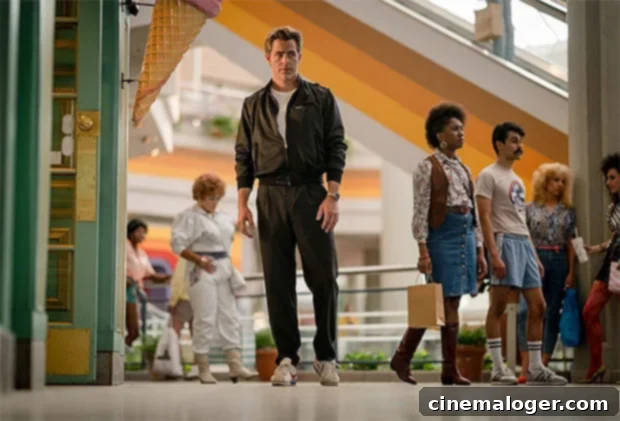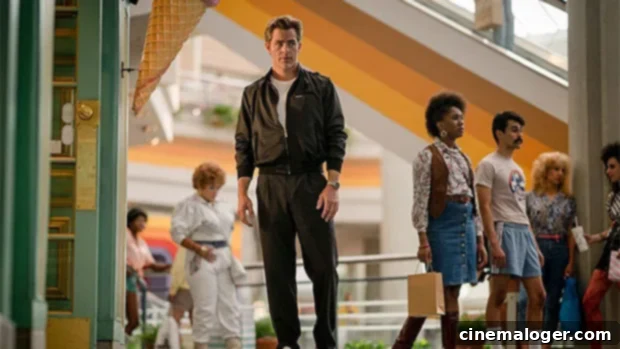Chris Pine’s Iconic Fanny Packs in ‘Wonder Woman 1984’: A Deep Dive into Steve Trevor’s Unexpected 80s Style Sensation
If you purchase an independently reviewed product or service through a link on our website, we may receive an affiliate commission.
The highly anticipated sequel, Wonder Woman 1984, finally made its debut on HBO Max, bringing a much-needed dose of superhero action and vibrant 1980s nostalgia to audiences worldwide. While fans eagerly anticipated seeing Gal Gadot return as the formidable Amazonian warrior, Diana Prince, it was an unexpected fashion choice by her co-star, Chris Pine, that truly stole the spotlight. Pine, reprising his beloved role as Steve Trevor, captured hearts not just with his charming performance but, more specifically, with his character’s distinctive array of fanny packs. These quintessential 80s accessories became an instant sensation, sparking widespread conversation and admiration across social media platforms, proving that sometimes, the simplest details can leave the biggest impression.
Steve Trevor’s return in Wonder Woman 1984 transported him from the battlefields of World War I into the dazzling, consumer-driven landscape of the 1980s. His charming bewilderment and earnest attempts to acclimate to this new era provided much of the film’s heartwarming humor. The wardrobe choices for Steve Trevor perfectly encapsulated this “fish out of water” narrative, with his evolving style becoming a visual representation of his journey. Among these, the fanny pack — or belt bag, as it’s sometimes known — emerged as the undisputed star. Throughout the film, Chris Pine’s Steve Trevor sported multiple variations of this practical yet now iconic accessory, each one adding to his endearing characterization. Fans couldn’t get enough of this sartorial statement, with social media lighting up with appreciative comments and memes.
The sheer delight generated by Steve Trevor’s fanny packs was palpable. One fan humorously tweeted, “I didn’t know what I needed for Christmas was Chris Pine in a fanny pack,” perfectly encapsulating the unexpected joy the outfits brought. Another enthusiastically declared, “i’m def gonna watch it 10000 more times to revel at chris pine in a fanny pack,” highlighting the immediate cult status of this fashion moment. Beyond individual praise, many viewers pointed out the quintessentially 80s aesthetic of combining a fanny pack with a classic tracksuit. “Chris Pine’s track suit and fanny pack combination in WW1984………..I need it,” one commenter exclaimed, indicating a strong desire to replicate the look. This combination didn’t just evoke nostalgia; it also cemented Steve Trevor’s place as an unexpected 80s style icon, flawlessly portrayed by Chris Pine’s natural charisma.
The fanny pack, an accessory that saw its peak popularity in the 80s and early 90s, often receives mixed reviews in contemporary fashion discussions. However, its inclusion in *Wonder Woman 1984* was nothing short of a stroke of genius. It served multiple purposes: authentic period detail, a source of character-driven humor, and an unexpected fashion statement that resonated deeply with viewers. For Steve Trevor, a man discovering the wonders of the modern world, the fanny pack perfectly represented his practical approach to carrying essentials while exploring a new landscape. It was a subtle yet powerful nod to the era’s utilitarian fashion, perfectly contrasting with Diana’s timeless elegance. This simple accessory became a focal point of discussion, proving that even a seemingly minor wardrobe choice can significantly impact a character’s portrayal and audience engagement.
Sign up for HBO Max here for just $14.99 a month!
Best part of WW84 is #ChrisPine in a fanny pack. @WonderWomanFilm pic.twitter.com/T2Rm17tuRZ
— Lauren Astore (@LLastory) December 26, 2020
The journey to the screen for *Wonder Woman 1984* was a prolonged one, marked by repeated delays due to the unprecedented challenges of the ongoing COVID-19 pandemic. Despite these hurdles, the film finally premiered on Christmas Day, a strategic decision that saw it released simultaneously on HBO Max and in select theaters and IMAX venues. This hybrid release strategy allowed a broad audience to experience Diana Prince’s latest adventure, contributing to its widespread discussion and the immediate virality of moments like Steve Trevor’s fashion choices. The film’s global reach through HBO Max amplified the conversation around its stylistic elements, further cementing the fanny pack’s place in popular culture.
Beyond the undeniable charm of Steve Trevor’s 80s wardrobe, *Wonder Woman 1984* also delved into the rich lore of the DC Comics universe, offering tantalizing glimpses into the future of Diana’s journey. A particularly significant moment came during the post-credits scene (warning: spoilers ahead for those who haven’t seen it). Director Patty Jenkins skillfully brought a narrative thread full circle, reinforcing the depth of Wonder Woman’s mythology. Earlier in the movie, Gal Gadot’s Diana recounts the legendary tale of a powerful and valiant Amazonian warrior named Asteria to Chris Pine’s Steve. Asteria, renowned for her immense strength and bravery, possessed a magnificent suit of golden armor. During a perilous battle, she selflessly stayed behind to fight in her resplendent gold armor, allowing her Amazonian sisters to escape to safety. This act of profound sacrifice and heroism left an indelible mark on Diana, who has spent years searching for the lost warrior.

The flashback sequence depicting Asteria in battle, with her piercing blue eyes shining with determination, highlighted the warrior’s legendary status. Diana confessed to Steve that her quest to find Asteria herself had been fruitless, though she had eventually recovered the iconic golden armor – a symbol of unparalleled courage and sacrifice. This very armor, imbued with the spirit of Asteria, is later donned by Wonder Woman herself as she faces formidable adversaries: Kristen Wiig’s Cheetah and Pedro Pascal’s Max Lord. The visual spectacle of Diana in the shimmering golden armor was a significant moment for fans, symbolizing her connection to a deeper Amazonian legacy and her ultimate commitment to protecting humanity. The post-credits scene then revealed that Asteria is, in fact, alive and well, subtly teasing an exciting future for the franchise. This revelation has fueled rampant fan theories, with many speculating that a third *Wonder Woman* movie could see Diana and Asteria finally crossing paths, potentially uniting two legendary Amazonian figures on screen. This narrative development, combined with the stylistic flair seen in elements like Steve Trevor’s fanny pack, showcases the film’s dedication to both compelling storytelling and memorable visual details. Only time will truly tell what adventures await Wonder Woman and the future of the DC Extended Universe, but one thing is certain: *Wonder Woman 1984* delivered a cinematic experience filled with heart, heroism, and unforgettable fashion statements.
In conclusion, *Wonder Woman 1984* not only delivered a compelling narrative and stellar performances from Gal Gadot and Chris Pine but also solidified its place in pop culture history through unexpected details. Chris Pine’s portrayal of Steve Trevor, particularly his adoption of the humble fanny pack, became a surprising highlight, celebrating 80s fashion with an endearing authenticity that delighted fans globally. This fashion moment transcended mere costume design, contributing significantly to the character’s charm and the film’s overall nostalgic appeal. As discussions about retro fashion continue to cycle through trends, Steve Trevor’s fanny packs serve as a charming reminder of how specific wardrobe choices can become cultural touchstones, sparking conversation and inspiring a renewed appreciation for vintage style. The film successfully blended action, emotion, and iconic fashion, leaving audiences with much to discuss, from powerful Amazonian legends to the ultimate accessory of the 1980s.
